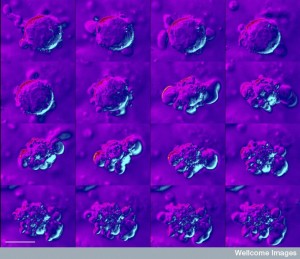By Veronica Rezelj, PhD student @verorezelj
As we’re now in the run up to the International Meeting on Arboviruses and their Vectors, being held in Glasgow with the Society for General Microbiology (#IMAV15), , we’d like to introduce you to an expert who works in the fascinating field of arbovirus research. This is our second in a series of posts about arboviruses. Why? Because IMAV 2015 is an important event – and what better way to share the conversations and learnings we’ll get the opportunity to take away from it.
The CVR holds a series of external seminars throughout the year, inviting excellent world-renown virologists to give a talk and meet CVR researchers. I was lucky to meet Prof John Fazakerley in March this year, after his captivating talk titled “Alphavirus, encephalitis and arthralgia”. John is a recognised leading scientist on arthropod-borne viruses (arboviruses) and viral pathogenesis. He is the Director of the Pirbright Institute, as well as the group leader of the Arbovirus Pathogenesis Group in Pirbright. Prior to taking the position, John was a Group Leader and Professor of Virology at the Roslin Institute at the University of Edinburgh.
Walking back from the lecture theatre to the meeting room where our interview was going to take place, we got caught up in an interesting discussion about his talk, our research interests and my PhD project. With only 10 minutes left before our interview time was over, it was time for me to ask the questions I had prepared for the blog.
In 2011 you took the post as Director of the Pirbright Institute, a world leading institute with an excellent reputation in animal virology. Did you ever think you would end up in such a prestigious position?
I didn’t think I would be the director of Pirbright. Interestingly though, in my mid-career I had a very good friend of mine, who was actually the best man in my wedding, who lived just near Pirbright and I remember going to stay at his house. I think I was working in Cambridge at the time…I said: “What’s this place?” And he said “Ah, it’s a virology institute…” and I said: “Oh, right, it’s a bit strange, they’re behind all of this barbed wire!” That was my first sight of Pirbright, but I never thought I would end up being the director of it.
“Arthropods have a rather different immune system, like most of nature…It is the vertebrates that are strange or unusual!”
Were you a virologist back then?
Yes and no. I started off doing immunology…I did my PhD in Immunology, but on the immunology of a virus. Then over the years I focused on immunology and virology because I was interested in pathogenesis: how the virus causes its disease and the ways it has evolved to either stop it or indeed exacerbate it. I try to keep both going…
One of the aims of the arbovirus pathogenesis group in Pirbright is to investigate why arboviruses are generally persistent and non-cytopathic in arthropod cells, but cytopathic in most mammalian cells. Why do we think this is?
I think it’s really to do with the species. Mammals have become quite sophisticated in many respects, and the first response that a mammalian cell upon sensing that it has a viral infection (and it’s important for the cell to be able to sense that it has a viral infection), is coupling the apoptotic machinery of the cell to detect that there is a virus infection. Therefore one of the first things that most mammalian cells try to do upon being infected with a virus is to die. If they can die fast enough, that eliminates the virus infection. And viruses have responded in having anti-apoptotic genes. So if you look at any large DNA virus certainly, they actually have genes that are anti-apoptotic so they stop this apoptotic process, which also is a testament to the fact that it’s a very effective process and it will control a virus if you let apoptosis just happen.

There are some exceptions to vertebrate cells and those are neurons and macrophages, and possibly other post-mitotic important cell types. Your post-mitotic neurons are going to help you for life, in the case of a human maybe 90 years or so, and you don’t want these to undergo apoptosis upon virus infection. The consequence is virus persistence.
Now the arthropods are different. Arthropods have a rather different immune system, like most of nature…It is the vertebrates that are strange or unusual! Vertebrates have got an adaptive immune system whereas most of nature relies on RNAi to get rid of virus infection. Plants and all invertebrates use RNAi, and arthropods are no exception. What happens in this section of nature is that viruses are tolerated as long as you can get them down to very low levels. So what happens in the arthropod is that the RNAi controls the virus infection and the detection of virus has not become linked to the apoptotic process. And arthropod cells do not seem to switch on apoptosis when they’re virus-infected.
Which makes sense, an arbovirus wouldn’t want to kill its vector…
Yes, and there is another side to that. The arthropod hasn’t linked apoptosis to virus detection so the arthropod cell doesn’t die. But it also doesn’t need to because low level of virus infection is fine for the arthropod. However, some viruses have evolved to have genes which suppress RNAi, so insect-only viruses tend to have suppressors of RNAi. This means that they can then replicate to really high levels in the arthropod, and that really high level of virus results in destruction of the arthropod cell and death of the arthropod. Then the virus gets aerosolized and that’s part of its transmission to the next arthropod.
In the case of an arbovirus, it doesn’t want to kill its vector. Even though there are examples of arboviruses which have weak inhibitors of RNAi, they do not seem to have evolved strong inhibitors of RNAi. Therefore what they need is the arthropod to be transmitted to the next vertebrate, because it’s in the vertebrate that they are going to have a massive increase in the number of genome copies. And generally that is a vertebrate in which the virus can suppress the innate immunity so that it can replicate to really high levels so they can be taken up by another arthropod. And again the arthropod is having a low level of replication which doesn’t damage the arthropod cell, which doesn’t undergo apoptosis, the virus is persistent and then is passed on to the next vertebrate and the cycle continues…
Your research involves in vitro and in vivo studies. As virologists, we always ask ourselves if the findings we see in vitro are valid also in vivo, and we might find that both systems work very differently. Do you think we could foresee in the future more in vivo studies rather than in vitro?
I’ve always strongly believed that there are only some things you can study in vitro. Let’s take a cell like a neuron. If you wanted to study a virus that causes encephalitis because it gets into neurons, you could study it in BHK (Baby Hamster Kidney)-21 cells, which is not a neuron, but can be continuously passaged in cell culture. And what you’ll find is that the virus replicates in BHK cells, BHK cells detect virus infection and undergoes apoptosis within 24 hours. But is that what happens in vivo in neurons? No, because when you put the virus into neurons what you’ll find is virus persistence in neurons in many mammals.
“I think over the course of my scientific career we’ve lost a lot of people that do in vivo work, actually.”
So what’s the difference? Well, we could speculate that the difference is the fact that the neuron is a neuron and a BHK cell is a BHK cell, but another difference is that a neuron is a postmitotic cell and the BHK cell is continuously dividing. Now you can’t possibly study that postmitotic cell in cell culture because by nature it’s not dividing. There are systems where you can get immature neurons and try to mature them by using various factors so that they become mature neurons in culture. But sometimes you can’t do things in vitro, so you have to do them in vivo. And of course in vivo you have the whole immune system which you don’t have in vitro.

So I think that’s very important, and certainly in pathogenesis. But I think over the course of my scientific career we’ve lost a lot of people that do in vivo work, actually. Because a lot people moved to do in vitro work, and part of it is that in vivo work is far more complicated and produces results less quickly. Additionally, you need a broad range of skills because you have to understand your virus, the tissues in which it replicates, the immune system. And if it’s something complex you’re dealing with like encephalitis, you need to understand the nervous system and neuropathology, which is in itself quite complex. Progress is perhaps a lot more difficult than it is studying something in vitro. in vivo science has been somewhat forced out by the people looking at metrics. How many papers did you publish? How many this year? In which journal? And in vivo stuff often didn’t make the headlines. Plus, there is the expense of doing in vivo studies.
Would you say there is a need for more in vivo studies?
I think there certainly is, yes. And I suggest the way we should do that is in specialist centres. Because I don’t think every centre can have its specialists, animal facilities and appropriate containment. And now in vivo has the possibility to get much more sophisticated with new imaging techniques. So you can do in vivo imaging, MRI, SPECT analysis with short half-life isotopes. All these are very powerful techniques, but not every organisation, institute or university is going to have their facility to do this. So in vivo studies need to concentrate in fewer, more specialised centres.
*********************************************************************************************************************
The MRC-University of Glasgow Centre for Virus Research will host the 2015 International Meeting on Arboviruses and their Vectors (#IMAV15), as a Society for General Microbiology-sponsored ‘focus meeting’.#IMAV15 will be held on Monday 7th and Tuesday 8th September 2015 in Glasgow and confirmed speakers include Marco Vignuzzi (Pasteur Institute, France), Michael Diamond (Washington University in St Louis, USA), Lisa Fong Poh Ng (A*Star, Singapore) and Zoe Curtis (Oxitec, UK).
The CVR has a broad, collaborative programme on arboviruses as part of its ‘Emerging & zoonotic viral infections’ theme. In particular, the CVR investigates their molecular virology, virus-host interactions, vaccine development and vector biology across the different programme member labs of Alain Kohl, Esther Schnettler, Emilie Pondeville, Margus Varjak, Richard Elliott and Massimo Palmarini. This strategy allows us to be prepared for future, often unpredictable, problems with arboviruses, but also work on ongoing issues.
*********************************************************************************************************************


